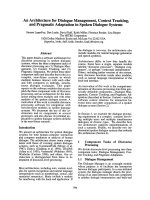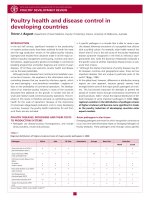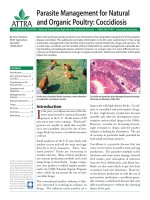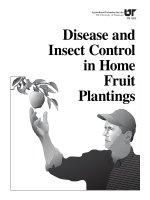Integrated pest management for pest and disease control in ornamental crops ( PDFDrive )
Bạn đang xem bản rút gọn của tài liệu. Xem và tải ngay bản đầy đủ của tài liệu tại đây (9.95 MB, 187 trang )
Integrated pest management for
pest and disease control in
ornamental crops
Brinsbury College Campus, 8 November 2016
Seminar programme
Time
Subject
Speaker
13.30
Tea/coffee/biscuits and registration
13.55
Introduction to the seminar by the event Chairperson
Richard
Fargro
14.00
Essentials of IPM
The control of key pests using biological control agents
Neil Helyer, Fargro
14.45
Use of nematodes, including their application, for the Jorge Tirado, BASF
control of a range of pest species
15.15
Tea/coffee/biscuits
15.30
The secrets of successfully combining plant protection Josh Burnstone
products within an IPM programme
David Hide, Fargro
16.15
Creating IPM programmes for key crop groups – protected Neil Helyer, Fargro
ornamental crops and hardy nursery stock
16.45
How research is improving IPM performance
Jude Bennison, ADAS
17.15
Panel question and answer session
All
17.30
Depart
Hopkins,
MD
and
Integrated pest management
for pest and disease control in
ornamental crops
Essentials of IPM
Aphid, whitefly, thrips and spider mite
control in IPM programmes
Neil Helyer, IPM Specialist
Fargro Ltd
Most images copyright Nigel Cattlin
Integrated pest management
• Definition: A systems approach
that combines different crop
protection practices with careful
monitoring and the use of natural
enemies. Sustainable Use
Directive: legal requirement as of
1 January 2014.
Integrated pest management
• Cultural: general hygiene, ground cover
materials, weed control, plant movement,
change cultivar, monitoring, sticky traps.
• Biological: parasitoids, predators and
pathogens.
• Environmental: disease control for plant and
insect pathogens.
• Pesticide backup with selective chemicals.
Sustainable use of pesticides
Sticky trap orientation
100 / ha for monitoring, up to 1 / 2
per m2 for mass trapping
Clean-up and spot sprays
• Chess WG + Dynamec: when average
temperatures exceed 12 to 15oC for aphids and
spider mites, use higher rate of Chess (EAMU) for
leaf hopper and whitefly, higher rate (on label)
for leaf miner and thrips.
• Chess WG fully safe to majority of beneficials.
• SB Plant Invigorator, Majestik, contact spray.
• Borneo + Dynamec + Attracker for spider mites.
• Gazelle + Dynamec + Attracker end of season
clean-up; before diapause.
Aphid control by parasitoids
Aphidius species of
parasitic wasps
• 1 : 1, up to 60 eggs /
female wasp.
• Temperature 10 - 25oC.
• Good at 15oC up to 30oC.
• Naturally found from
spring onwards.
Aphid control by predators
Aphidoletes aphidimyza
• 1 : 5 to 35, up to 100
eggs per female.
• Temperature 12 - 28oC.
• Nocturnal flying adult.
• Minimum 15.5 h day
length to recycle.
• Flight temp 18oC.
• Ideal spring onwards or
for heated crops.
Aphid control by predators
Chrysoperla carnea (green
lacewing larva)
• 1 : 250 aphids, more of
other prey.
• Feed on most soft bodied
prey.
• I
organic crops.
• Can be introduced to
hedges to prevent pest
migration.
Aphid control by pathogens
Naturalis-L / BotaniGard
Beauveria bassiana
• 1 : 1,000,000 (++).
• Min 60% Rh, 80% at leaf
surface.
• Good curative, produces
epizootic infection.
• I
mixing with nematodes
and most insecticides.
• Pandora neoaphidis
Aphid control with pesticides
•
•
•
•
•
•
•
•
•
Aphox: systemic, translaminar, vapour. IRAC 1A
Calypso: contact, systemic.
IRAC 4A
Chess: contact, systemic, translaminar. IRAC 9B
Gazelle: contact, systemic.
IRAC 4A
Movento: contact, systemic.
IRAC 23
Naturalis-L, BotaniGard: contact.
IRAC exempt
Plant Invigorator: contact.
IRAC exempt
Pyrethrum 5 EC: contact, short persistence. IRAC 3
Decis, Hallmark: contact, long persistence. IRAC 3
P
M A
• Insecticides: target pest usually has to be active;
generally active above 8oC.
• Diapause and hidden life stages.
• Contact: requires good spray coverage, sedentary
target is best.
• Systemic: moves throughout the plant, good
spray coverage, HV is best.
• Translaminar: moves through sprayed leaf, good
spray coverage, 2 3 hr as wet residue.
• Translocated: moves from one part to another
within plant.
Whitefly
Glasshouse whitefly control by parasitoids
Encarsia formosa
• 1 : 1 up to 60 eggs per
female wasp.
• Min temp 12oC.
Eretmocerus eremicus
• 1 : 1 up to 50 eggs per
female wasp, host
feeding is high.
• Min temp 17oC but
good up to 40oC.
Whitefly control
Macrolophus pygmaeus
• 1 : 500 +, 70 eggs per
female.
• Mediterranean origin.
• Min temp 15oC.
• Licensed for use on
protected crops in
production.
• Supplementary food.
Aubergine as a trap / banker plant
Calendula, salvia, tomato
Whitefly control by pathogen
Beauveria bassiana
Lecanicillium lecanii
• 1 : 1,000,000.
• Min 60% Rh, (B. bass)
95% at leaf surface (L.
lecanii).
• Slow curative.
• I
selective pesticides.
Thrips
• Western flower thrips
and others.
• Wide host plant range.
• Virus transmission.
• Severe economic
damage to fruiting and
flowering plants.
• Pesticide resistance.
• Aggregation pheromone.
Thrips control
• Synthetic version of sex aggregation pheromone
as produced by males, attracts both male and
female WFT. Thripline ams.
Kairomone lures; Lurem TR
Thrips control by predatory mites
Amblyseius species
• Attack young larval stage.
• Preventative, eat 1 - 2
first instar larvae.
• Can feed on other food
sources; pollen,
trichomes, extra floral
nectaries.
• Prefer leaves with hairs.
• CRS sachets or loose
carrier material.
Predatory mites
Amblyseius cucumeris
• Controlled release
system (CRS) sachets.
• Waterproof bag.
• Active for 6 - 8 weeks.
Thrips control by predatory mites
Hypoaspis miles
Soil living predator
eats larvae / pupae of
sciarid and other
pests.
Thrips control by predatory insects
Orius species (flower bugs)
• Adults and larvae eat most
stages of thrips, 1 : 35
larvae / day.
• Good on long season crops.
Chrysoperla carnea
• Generalist predator of most
soft bodied pests: aphids,
mealybug, moth eggs,
spider mites/caterpillar, etc.









